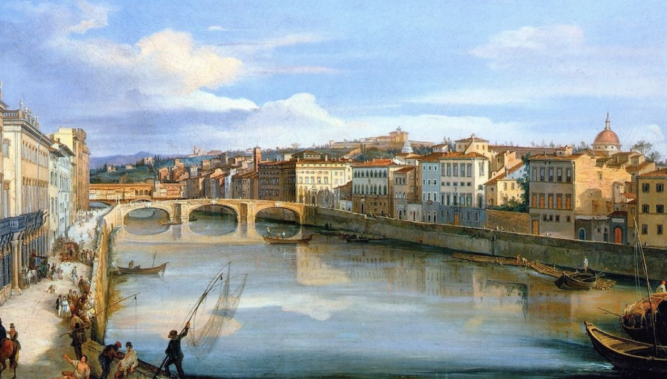The Florence of Giovanni and Telemaco Signorini: a Tuscan Impressionism Show

Until November 10: THE FLORENCE OF GIOVANNI AND TELEMACO SIGNORINI.Palazzo Antinori 3. Open Tuesday – Sunday 10 am to 6 pm. Admission full: € 13 or reduced: € 10.
In the calm oasis of Palazzo Antinori, away from the many packed streets of Florence, visitors can view scenic and historic paintings by Florence-born artists Giovanni and Telemaco Signorini. The exhibition, “The Florence of Giovanni and Telemaco Signorini,” (La Firenze di Giovanni e Telemaco Signorini) holds over 60 paintings by Telemaco Signorini, and his father, Giovanni, as well as several other Tuscan painters who worked in the second half of the nineteenth century. The exhibition displays a familial bond between father and son as well as the family’s relationship to the city of Florence.
In 1852, Telemaco Signorini was taught at the Florence’s Academy of Fine Arts to paint landscapes capturing natural light, shade and color. Signorini adopted the style and becomes one of the forerunners of the Impressionist movement in Italy, the Macchiaioli, a group of Italian painters especially active in Tuscany. Telemaco and Giovanni’s paintings mirror Florence during a time when it was beginning to define itself, first as the capital of Italy and then as a modernizing city. As well, many of the paintings created by the Signorini family document the evolution of landscape painting in Tuscany.
One of the paintings on display, “Mercato Vecchio” (1882-1883) by Telemaco Signorini famously depicts the Mercato Vecchio ‘old market’ in Florence while it was crowded and full of life. After this busy square was evacuated, the buildings were torn down for the modernization of Florence in the mid-nineteenth century and is today the Piazza della Repubblica. Signorini’s painting is one of the most notable representations of the Old Market before it was destroyed–there are no photographs of the market while it was in full use, with people occupying the streets and buildings. The scene is lively and full of movement, different from many of Signorini’s serene pieces, like vast landscapes that evoke a melancholy feeling.
Palazzo Antinori is a perfect place to hold this exhibition because it was once owned by a family intent on preserving the historical value of Florence. Now, in the beautiful, cavernous rooms of Palazzo Antinori, hang painted images of alleyways, gardens, antique buildings, bridges across the Arno, street corners, and many more in heavy gold frames. (alexandra reilly)
